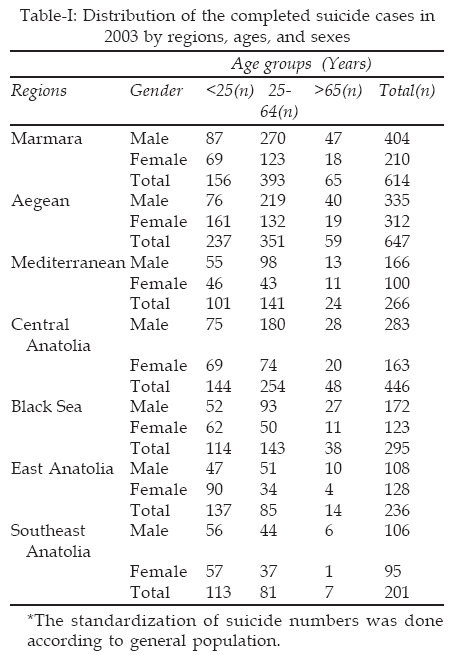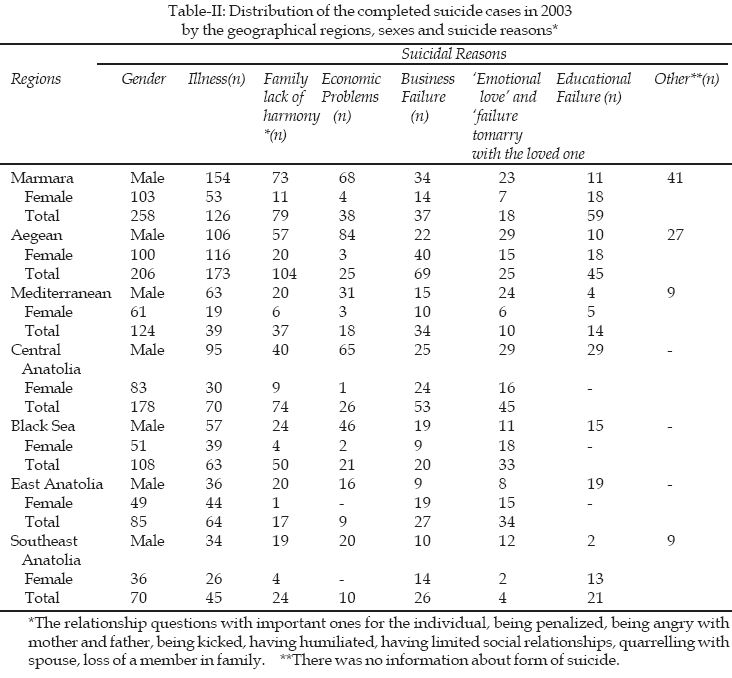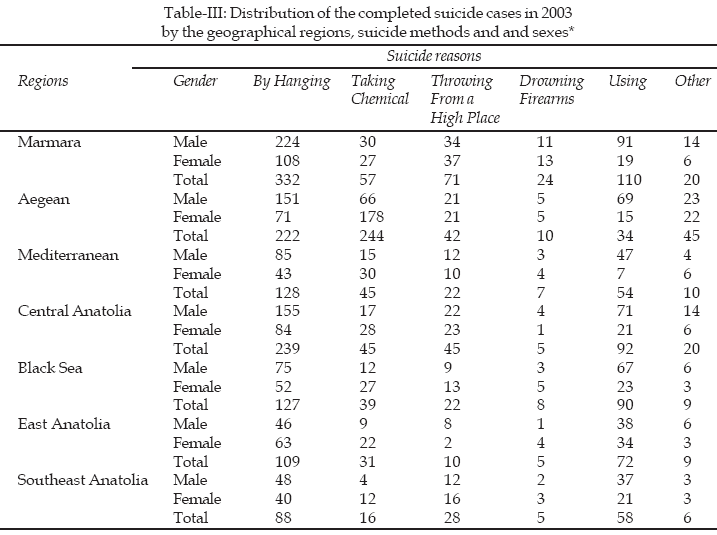|
 |
|
Published
by : PROFESSIONAL MEDICAL PUBLICATIONS |
|
ISSN 1681-715X |
|
|
|
|
|
- |
|
ORIGINAL
ARTICLE |
|
- |
|
Volume 25 |
April
- June 2009 (Part-II) |
Number 3 |
|
|
|
Geographical differences in completed
suicides in 2003 by gender in Turkey
Cinar Yenilmez1, Setenay Oner2, Unal
Ayranci3,
Yasemin Kilic4, Gulcan Gulec5
ABSTRACT
Objective: To determine the gender differences
between in terms of the method and reason of suicide.
Methodology: The suicidal proportions in seven
regions of Turkey by sexes were compared according to three different age
groups. The data were evaluated by Loglinear analysis.
Results: Suicide rates were higher in women in the
region East Anatolia (P<0.01). It was found that suicide by hanging was the
most commonly used method in all the regions (P<0.001). Committing suicide by
hanging (P<0.01) and using firearms (P<0.001) were higher in men, whereas,
committing suicide by taking chemical was higher in women (P<0.001).
Conclusion: Gender differences in suicidal behavior
in this study clearly merit further research to generate information that can
guide clinical practice and prevention strategies.
KEY WORDS: Geographical regions, Suicide, Gender
differences, Suicide methods.
Pak J Med Sci April - June 2009 (Part-II)
Vol. 25 No. 3 484-489
How to cite this article:
Yenilmez C, Oner S, Ayranci U, Kilic Y, Gulec G. Geographical differences
in completed suicides in 2003 by gender in Turkey. Pak J Med Sci 2009;25(3):
484-489.
1. Cinar Yenilmez,
2. Setenay Oner,
Department of Biostatistics,
Medical Faculty,
3. Unal Ayranci,
Medical Social Centre,
4. Yasemin Kilic,
5. Gulcan Gulec,
1,4,5: Department of Psychiatry,
Medical Faculty,
1-5: Eskisehir Osmangazi University,
26480 Meselik Eskisehir,
Turkey.
Correspondence
Unal Ayranci,
Medical Social Centre,
Eskisehir Osmangazi University,
26480 Meselik Eskisehir,
Turkey.
E mail: unalayrancioglu@yahoo.com
* Received for Publication: August 6, 2008
* Revision Received: May 9, 2009
* Revision Accepted: May 13, 2009
INTRODUCTION
Suicide is the act of deliberately taking one’s own life.
Attempted suicide is 10-40 times more frequent than completed suicide, and is
the strongest single predictor of subsequent suicide. Suicidal behavior is
defined as any deliberate action with potentially life-threatening
consequences, having tragic results, and accompanying various emotional
disturbances including depression, bipolar disorder, and schizophrenia,
sociological, economic, genetic, familial, religious, existentialistic,
historical, occupational and cultural factors.
1,2
The elderly have the highest rate of suicide, but there has
been a steady increase among adolescent and young persons.
3
Some researchers have indicated that there was a relationship between physical
illness and suicide in especially elderly people.4
Any negative change in one’s social status increases the risk of suicide. In
parallel, in those with lower socioeconomic status the risk for suicide is
higher.5
Postmortem studies have showed that 25-75% of those
committing suicide had some kind of physical illness, suggesting a complex
relationship between suicide and physical disorder.
6,7
In addition, it has been reported that comorbide conditions, schizophrenia and
substance habit, primarily affective disturbances are most frequently seen
mental diseases related to suicides.8
Some studies have indicated that the incidence of suicides increase as
economic crisis and unemployment increase, and that the opposite is also true.7,9
The differences in suicide behaviour between young men and
women have been known for years.
10
Literature search has showed that young women have higher rates of attempted
suicide, compared to young men while completed suicide rates in young men are
three times higher than in young women5,11
Suicidal young men were 8 times more likely than non-suicidal counterparts to
be living alone, in care or hostels or without a family structure.12
Those who are single, divorced and separated are more
likely to commit suicide when compared to those married, which probably
accounts for the fact that suicide attempts by males are more likely to be
completed. In addition there are many studies which show that having a child
is a protective factor from suicides.
3,13
In Turkey, when compared to the
other European countries, the attempted suicide rates were lower, and the
increase in the suicide rate among younger women attracted attention.9,14
The suicide method can be nonviolent such as poisoning or
overdose or violent such as shooting oneself. The use of violent methods as
compared to non-violent methods was higher in men, which probably accounts for
the fact that suicide attempts by males are more likely to be completed. Many
suicides involve a firearm. This is especially true in elderly men.
15
In this study, we have found that the characteristic of
suicide behaviour could be related to the region’s features and the society’s
structure. The aim was to determine the differences between the gender in
terms of the method and reason of suicide in completed suicides in different
age groups in Turkey and also to call attention to the risk factors peculiar
to the region, being related to the society’s structure.
METHODOLOGY
Turkey is divided into seven regions: the Black Sea region,
the Marmara region, the Aegean, the Mediterranean, Central Anatolia, the East
and Southeast Anatolia regions. In this retrospective study, we used Annual
Reports of Suicide Statistics published periodically by the Turkish State
Institute of Statistics.
16,17
We then determined demographic characteristics such as age and sex, suicide
method and suicide reasons of those cases through the statistics. Lastly, the
data obtained from suicide files were registered on a datum collection form
prepared by the researchers. Since the comparison of the data related to those
variables with the regions of Turkey was done in the year 2003, the data of
the year 2003 were used.
The completed suicide proportions in seven regions of
Turkey by sexes were compared according to three different age groups, namely
those below age of 25, those in age groups of 25-64 and those in age of 65 and
over.
Statistical Methods:
The data collected were evaluated by
Loglinear analysis using SPSS 11.0 packet program.
RESULTS
The distribution of the completed suicide cases in 2003 by
regions, ages, and sexes is presented in Table-I. For the completed suicide
cases in 2003, it revealed an important relationship between the geographical
regions and age groups (c
2=124.83,
P<0.001). The suicide rates was higher in the regions East Anatolia (z=8.14,
P<0.001, 95% CI=1.71-2.79) and Southeast Anatolia (z=7.21, P<0.001, 95%
CI=1.98-3.46) for those under age 25, whereas the suicide rates for those
between 25 and 64 ages group were higher in the regions Marmara (z=13.44,
P<0.001, 95% CI=1.53-2.06), Eagean (z=12.67, P<0.001, 95% CI=1.50;2.05),
Central Anatolia (z=10.58, P<0.001, 95% CI=1.35;1.97), Mediterranean (z=8.01,
P<0.001, 95% CI=1.33;2.18) and Black Sea (z=7.25, P<0.001, 95% CI=.96;1.67)
than those of the other regions. In the suicide rates, there was an important
connection between the regions and sexes (c2=50.00,
P<0.001). Suicide rates were higher in women in the region East Anatolia
(z=2.69 P<0.01, 95% CI=.12-.78), while it were higher in men in the other
regions. For the year 2003 suicides, there was an important relationship
between the age groups and sexes (c2=118.94,
P<0.001). While female suicide rate under age 25 (z=5.33 P<0.001, 95%
CI=-.45-.97) was higher than in men, the rates were higher in men in the age
groups between 25 and 64 and 65 and over.

The distribution of the completed suicide cases in 2003 by
the geographical regions, sexes and suicide reasons is presented in Table-II.
It reveals that, illness (z=3.12, P<0.01, 95% CI=.88-1.77), educational
failure (z=-2.45, P<0.05, 95% CI=-3.04-.34) and business failure (z=-2.29,
P<0.05, 95% CI= -6.12-0.48) were found as the most important reasons for
suicides. In suicide cases, there was an important connection between
geographical regions and suicidal reasons (x˛=240.99, p<0.001). The suicide
rates were found to be higher in the Aegean region due to economic problems
(z=2.18), due to the illness in the Mediterranean region (z=2.50), due to
educational failure in the Central Anatolia Region (z=4.05) and the Black Sea
Region (z=3.84), due to lack of family harmony in the East Anatolia and
Southeast Anatolia regions (z=-2.66). There was an important relationship
between the suicide reasons and sexes in the completed suicides in 2003 (c2=252.96,
P<0.001). It was determined that economic problems (z=5.86, P<0.001, 95%
CI=.88-1.77) and business failure (z=5.50, P<0.001, 95% CI=1.18-2.49) in men
were the most important reasons of suicides, and also suicide rates were
higher due to lack of family harmony (z=12.256 P<0.01, 95% CI=1.5-2.08),
‘emotional love’ and failure to marry the loved one. (z=-5.41, P<0.001, 95%
CI=.56-1.19)

The details of the completed suicide cases in 2003 and the
methods used are shown in Table-III. In suicide cases, there was an important
relationship between geographical regions and suicide methods (c2=337.29,
P<0.001). It was found that suicide by hanging was the most commonly used
method in all the regions except the Aegean region (z=6.43, P<0.001, 95%
CI=1.82-3.41). In the year 2003 suicides, there was an important connection
between suicide methods and sexes (c2=22.86,
P<0.001). Committing suicide by hanging (z=14.93 P<0.01, 95% CI=1.94-2.53) and
using firearms (z=6.31 P<0.001, 95% CI=.72-1.37) were higher in men, whereas
committing suicide by taking chemical was higher in women (z=12.32 P<0.001,
95% CI=1.58-2.18).

DISCUSSION
In this study, in the age groups between 25-64 and 65 and
over, male suicide rates were higher than in women. However, in the age group
24 and below female suicide rates were higher when compared to that of men.
This is in contrast to the earlier studies which show that suicide rates for
male gender in age groups 24 and below have increased.
11,13
Our findings that the suicide
rates among young women were high is in line with the study by Cheng et al
indicating that female suicides were higher in the age groups 15 and below and
between 15 and 24.18
When we look at the differences between the geographical
regions, the highest female suicide rates were in the regions East and South
East Anatolia, while male suicide rates were in the other regions. On the
other hand in the regions East and South East Anatolia, the most important
reason for suicide was determined to be lack of family harmony. The factors
such as living in rural areas, destitution, unemployment, social isolation,
having firearms could explain suicide behaviour in those regions in Turkey.
19
In a psychological autopsy study conducted in a city in the
Southeast Anatolia region of Turkey by Batman, it was determined that the most
frequently completed suicide rates were seen in women.
14
The reasons for this difference may be that the proportion of female
illiteracy in the East and Southeast Anatolia regions is very high, girls do
not go to the schools or they are not sent to the schools, migration
phenomenon from rural to urban cities, marriages by Imam wedding is very
widespread, girls get married in early ages, social changes are rapid, young
girls do not tolerate their own realities or identities in patriarchal family
structure.
Our finding are in agreement with previously conducted
studies,
3,20
which had shown that there was an important relationship between the suicide
methods and sexes. Apart from the East and South East Anatolia regions, in all
other regions, we determined that committing suicide by hanging and firearms
were higher in men, whereas taking chemical was rather more in women. In the
light of these results, we concluded that men preferred more aggressive
methods. This result is also in line with the studies indicating that a higher
proportion of women used pesticide to kill themselves,21
and that especially for female suicide by self-poisoning, agricultural
chemicals were founded to be the most frequently used substances.22
In a study concerning the differences in methods, it is a recognized fact that
males use violent methods in both suicide and attempted suicide more often
than females who use methods that cause less stinging sensation and less
making them ugly.23
Another study, showed women who commit suicide use less violent methods, such
as drugs and carbon monoxide poisoning, than do men, who more often use
violent methods such as guns and hanging.24
Our study has shown that in all
the regions apart from the Aegean region, the most frequently employed methods
of suicide were hanging. Correspondingly, hanging was an easy and reliably
lethal method that was most common in many countries.25,26
According to the unemployment proportion of the year 2003
of the State Statistics Institute, the highest proportion was in the region
Southeast Anatolia. An explanation for this could be that the unemployment
proportion increased from 224,000 to 400,000 with a proportion of 100% in
2003, when compared to the proportion in 2002.
27
In addition, although there are many studies indicating that the suicide rate
in the unemployed was higher than those in the employed,3
further studies concerning the effect on suicide of unemployment are
continuing.28
In another study, occupational changes, decrease of socioeconomic level and
non-stable job conditions were the factors affecting suicide,29
which is in consistent with our study.
CONCLUSION
Female suicide rates was higher in East and Southeast
Anatolia regions of Turkey, when compared to the other regions. This warrants
that the means being used by woman to commit suicide must be investigated in
those regions. This study is important in terms of the facts that the
completed suicides in the age 24 and below in Turkey is rather high. Moreover
it emphasizes the differences between the regions in the light of
socioeconomic characteristics. Thus, the findings of this study highlights the
need for further studies to initiate preventive strategies.
REFERENCES
1. Kaplan HI, Sadock BJ. Synopsis of Psychiatry. Eighth
Edition. Williams and Wilkins. Mass Publishing Co. Egypt, 1998.
2. Kelly CM, Jorm AF, Kitchener BA. Development of mental
health first aid guidelines for suicidal ideation and behaviour: a Delphi
study. BMC Psychiatry 2008;18;8:17.
3. Mościcki EK. Identification of suicide risk factors
using epidemiologic studies. Psychiatr Clin North Am 1997;20:499-517.
4. Quan H, Arboleda-Flórez J, Fick GH, Stuart HL, Love EJ.
Association between physical illness and suicide among the elderly. Soc
Psychiatry Psychiatr Epidemiol 2002;37:190-7.
5. Schmidtke A, Bille-Brahe U, DeLeo D, Kerkhof A, Bjerke
T, Crepet P, et al. Attempted suicide in Europe: rates, trends and
sociodemographic characteristics of suicide attempters during the period
1989-1992. Results from the WHO/EURO multicentre study on parasuicide. Acta
Psychiatr Scand 1996;93:327-38.
6. Peisah C, Snowdon J, Kril J, Rodriguez M.
Clinicopathological findings of suicide in the elderly: three cases. Suicide
Life Threat Behav 2007;37:648-58.
7. Haukka J, Suominen K, Partonen T, Lönnqvist J.
Determinants and Outcomes of Serious Attempted Suicide: A Nationwide Study in
Finland, 1996-2003. Am J Epidemiol 2008;15;167:1155-63.
8. Hawton K. Gender differences in suicidal behaviour. Br J
Psychiatry 2000;177:484.
9. Oner S, Yenilmez C, Ayranci U, Gunay Y, Ozdamar K.
Sexual differences in the completed suicides in Turkey. Eur Psychiatry
2007;22:223-8.
10. Walters P, Tylee A. Understanding depression in men.
The Practitioner 2004;247:598-602.
11. Guaiana G, D’Avanzo B, Barbui C. Update of suicide
trends in ýtaly from 1986 to 1996. Soc Psychiatry Psychiatr Epidemiol
2002;37:267-790.
12. Katz A, Buchanan A, McCoy A. Young Men Speak Out,
Samaritans, Ewell, Surrey, 1999.
13. Qin P, Agerbo E, Westergrd-Nielsen N, Eriksson T,
Mortensen PB. Gender differences in risk factors for suicide in Denmark. Br J
Psychiatry 2000;177:546-50.
14. Altindag A, Ozkan M, Oto R. Suicide in Batman,
Southeastern Turkey. Suicide Life Threat Behav 2005;35:478-82.
15. Bossuyt N, Van Casteren V. Epidemiology of suicide and
suicide attempts in Belgium: results from the sentinel network of general
practitioners. Int J Public Health 2007;52:153-7.
16. Statistical Yearbook of Turkey 2000. State Institute of
Statistics, Printing Division, Ankara, August, 2002.
17. Intihar Ist. T.C. Basbakanlik Turkiye Istatistik Kurumu
Yayin no:3020 CD, 2003.
18. Cheng AT, Chen TH, Chen CC, Jenkins R. Psychosocial and
psychiatric risk factors for suicide. Br J Psychiatry 2000;177:360-5.
19. Beautrais AL. Suicides and serious suicide attempts:
two populations or one? Psychol Med 2001;31:837-45.
20. Rich CL, Dhossche DM, Ghani S, Isacsson G.
Suicide methods and presence of intoxicating abusable substances: some
clinical and public health implications. Ann Clin Psychiatry 1998;10:169-75.
21. Paul SFY, Ka YL, Jianping H, Song XM. Suicide rates in
China during a decade of rapid social changes. Soc Psychiatry Psychiatr
Epidemiol 2005;40:792-8.
22. Lotrakul M. Suicide in Thailand during the period
1998-2003. Psychiatry Clin Neurosci 2006;60:90-95.
23. Voros V, Osvath P, Fekete S. Gender differences in
suicidal behavior. Neuropsychopharmacol Hung 2004;6:65-71.
24. Denning DG, Conwell Y, King D, Cox C. Method choice,
intent, and gender in completed suicide. Soc Psychiatry Psychiatr Epidemiol
2000;30:282-8.
25. Abe R, Shiori T, Nishimura A, Nushida H, Ueno Y, Kojima
M, et al. Economic slump and suicide method: Preliminary study in Kobe.
Psychiatry Clin Neurosci 2004;58:213-16.
26. Tamosiunas A, Reklaitiene R, Virviciute D, Sopagiene D.
Trends in suicide in a Lithuanian urban population over the period 1984–2003.
BMC Public Health 2006;6:184.
27. Suicide Statistics 2000. State Institute of Statistics,
Printing Division, Ankara, Turkey, 2002.
28. Platt S, Hawton K. Suicidal behaviour and the labour
market. In: K. Hawton and K. Van Heeringen, Editors, The international
handbook of suicide and attempted suicide, John Wiley & Sons, Chichester
2000;303-78.
29. Hawton K. Why has suicide increased in young males? Crisis
1998;19:119-24.
HOME
| SEARCH
| CURRENT
ISSUE | PAST
ISSUES
Professional
Medical Publications
Room No. 522, 5th Floor, Panorama Centre
Building No. 2, P.O. Box 8766, Saddar, Karachi - Pakistan.
Phones : 5688791, 5689285 Fax : 5689860
pjms@



